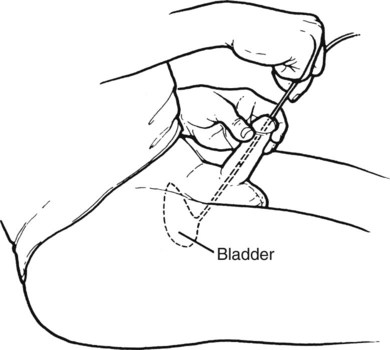This section may be photocopied and distributed to families. Call your health professional at ___________________ (phone number) if any of these occurs: 1. Have equipment ready; keep the tube in its container until you are ready to use it. 2. Wash your hands with soap and water. Count to 10 while washing, then rinse with clear water and dry with a clean paper or cloth towel. 3. Tell the child what you will be doing. 4. Catheterization can be done sitting, standing, or lying down. 5. Remove or arrange the child’s clothing so that it will not get wet and the urine can flow. 6. Wet the first 2 inches of the tube, either by placing lubricant on your finger and spreading it on the tube or by dipping the catheter into the lubricant on a clean tissue or paper towel. 7. Hold penis straight; if the child is uncircumcised, pull the foreskin back as far as it will go without forcing it. 8. Wipe the tip of the penis with towelette, baby wipe, or a clean washcloth with soap and water. 9. Hold the penis upright. Push the tube into the urinary opening gently (Figure 1). Just before the bladder you may feel some resistance. Do not push the tube in and out if resistance is met. Hold the tube and continue to move it in slowly, using gentle but firm pressure until the muscle relaxes. 10. Tell the child to take a deep breath and slowly let it out. This helps the child to relax. 11. Continue to insert the catheter until urine begins to flow. Then insert the tube about another 12. Push the foreskin forward if needed. Do not leave it pulled back. 13. Let all of the urine flow out. 14. Tell the child to squeeze his belly as if he were having a bowel movement or to blow bubbles or a pinwheel. This helps empty all the urine out of the bladder. 15. Slowly remove the tube; if urine begins to flow again, stop removing the tube and allow it to empty. 16. Wash your hands and the catheter with soap and water. Rinse the inside of the tube well with clear water. 17. PRAISE THE CHILD FOR HELPING. 18. Dry the catheter with a clean paper or cloth towel, and store it in a clean, dry container (e.g., plastic bag or margarine container). 19. Write down the time; whether the underwear or diaper was wet, damp, or dry; and the amount and the way the urine looks. 20. Never reuse a catheter that appears rough, stiff, kinked, worn, discolored, or damaged in any way. 21. Your health professional will tell you how often a new catheter should be used.
Wilson & Hockenberry: Wong’s Clinical Manual of Pediatric Nursing, 8th Edition
Patient Teaching Guide
Performing Clean Intermittent Bladder Catheterization*
Instructions for Boys
 inch and hold it there until urine stops flowing. Allow the urine to drain into a container or absorbent diaper, which can then be discarded.
inch and hold it there until urine stops flowing. Allow the urine to drain into a container or absorbent diaper, which can then be discarded.
![]()
Stay updated, free articles. Join our Telegram channel

Full access? Get Clinical Tree


Wilson & Hockenberry: Wong’s Clinical Manual of Pediatric Nursing, 8th Edition: Patient Teaching Guide
Get Clinical Tree app for offline access

